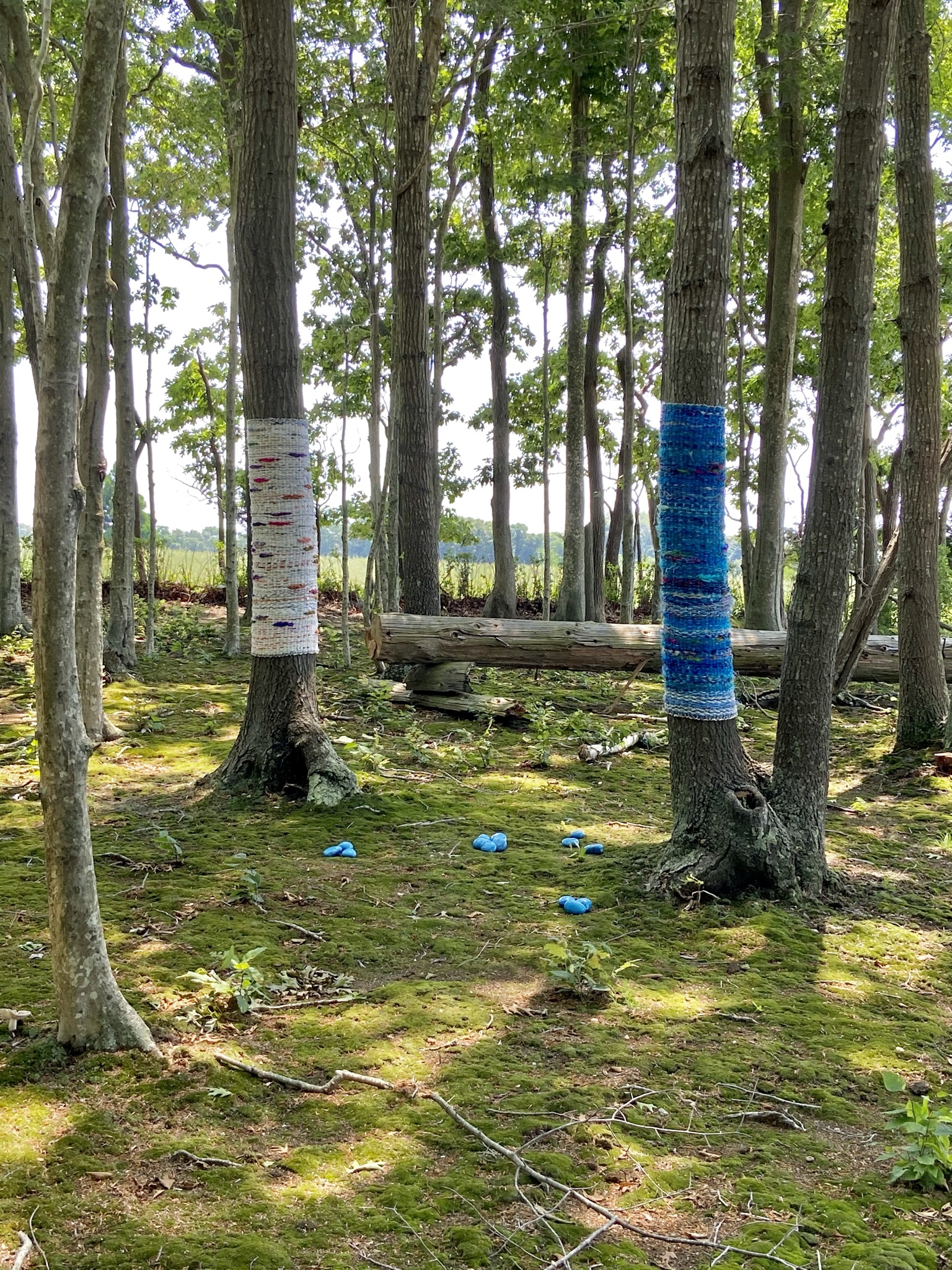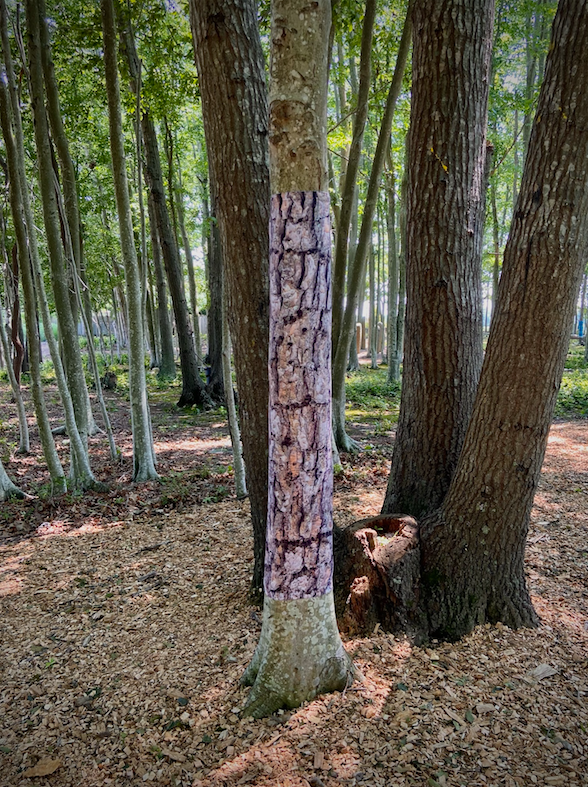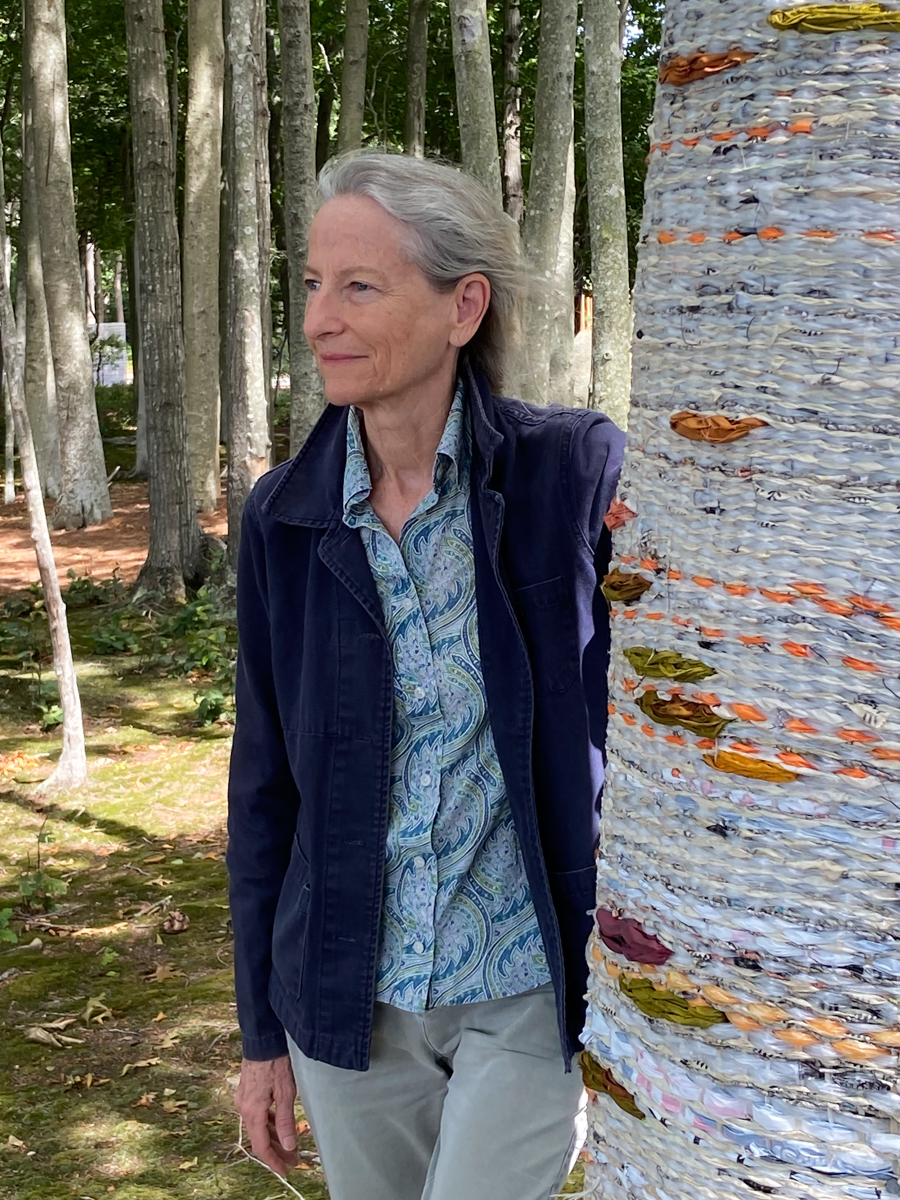
Watermill Center visitors and schoolchildren inspect ring of twigs by artist Laurie Lambrecht.
Laurie Lambrecht at Water Mill Center, NY Review by James FitzGerald
The sun is descending over a landscape that, at first glance, resembles many on the East End of Long Island: stands of oak and pitch pine, an understory of moss and blueberry, and yellow farm fields peeping through the trunks. However, a closer look reveals that this is no ordinary woodland. Some of the trees glow with blue, orange, purple, and white. Others appear to be masquerading in the bark of their neighbors; a beech tree has donned a girdle of pine bark, while an oak has cloaked itself as a conifer from base to the midriff.
This forest of shapeshifters is the creation of Long Island-based photographer and multimedia artist Laurie Lambrecht. “I want the work to be sympathetic with the landscape,” she explains. “I want to draw attention to details people would otherwise miss without detracting from the natural setting. My work shouldn’t be the first thing you see.”
The installation sits on the grounds of the Watermill Center, a center for the arts and humanities in Watermill, NY founded by theater director Robert Wilson in 1992. Lambrecht’s work provided the backdrop to the July 30 kick-off ceremony for the Center’s week-long summer festival, which also featured musician and performance artist Laurie Anderson and Shane Weeks, a multidisciplinary artist and member of the Shinnecock Nation.
Lambrecht’s work is spread across the 10-acre site, coming to the fore in some areas and camouflaging itself in others. Our walk began in a wooded corner of the property, where she has wrapped tree trunks in a weave composed of plastic newspaper bags, dyed silk, and a warp of marine ropes. Blue is the dominant color, but flashes of orange, white, and pink glimmer in the late afternoon sun. The land slopes gently upward, channeling slanted beams of light toward the trunks.
 Two oak trees which Lambrecht wrapped in weaving, with plastic-covered rocks beneath them.
Two oak trees which Lambrecht wrapped in weaving, with plastic-covered rocks beneath them.
The ground below is sprinkled with what appear to be bright blue robin’s eggs. On closer inspection, they turn out to be rocks wrapped in the same blue newspaper bags that festoon the trees. The unclothed rocks around them bear the trails of slugs. One, deposited by an unknown passerby, is inscribed with the word “acceptance.”
Lambrecht seems pleased by the ways in which these visitors, whether human or gastropod, have found ways to enter into dialogue with her work. She has been coming to the Watermill Center since soon after its founding and describes her work as the continuation of an ongoing conversation between land, artists, and visitors to the site. In recent years, she has examined how trees and vines intertwine and photographed these natural weavings. She has drawn inspiration from the woods and dunes of Long Island, where bittersweet vines and wild grapes form thick webs and tapestries.

Wrapped branches in the interior of the Watermill Center, New York.
The next stop on our tour is an oak grove where Lambrecht has wrapped trees in linen sheets bearing photographic prints of other tree species. These “hugging wraps,” which she debuted in her 2019 installation at the Madoo Conservancy in Sagaponack, New York, are designed to draw attention to trees and make people see them in new ways.

A beech in pine's clothing
In a clearing a few feet away sit several piles of twigs wrapped in yarn. They form a color wheel of blue, red, and green. Lambrecht made around two thirds of them, while the rest are the handiwork of schoolchildren at the Westhampton Beach Elementary School and kids who visited with their families on Community Day at the Center. When kids return to visit the site, Lambrecht tells me, they always race to find their own twig in the pile.

Wrapped twigs mark the edge of the forest.
The twigs, like the rest of the installation, will remain on site for the foreseeable future. However, the elements will ensure that they take on new hues and textures over time. Lambrecht is curious to see how the weathering process plays out. The color of the weavings, she says, has already changed and will continue to as the months wear on.
Time is also a force of change over the short term. Over the chirp of an osprey, Lambrecht tells me, “As I figured out how to integrate the work with the landscape, I was driven by the light. The site faces directly west, and a beautiful orange glow sketches its way across the sky every evening. I think of the weavings as sundials that situate you and give you a sense of beginning, middle, and end.”
laurielambrecht.com

Photo credit: Terri Gold
James FitzGerald recently became a member of ecoartspace. He is a graduate student at the University of Cambridge, studying international environmental law and policy. FitzGerald currently serves as an editorial intern at Orion magazine, a quarterly publication focused on culture, place, and the natural world. As a nature lover raised on the East End of Long Island, he has long been familiar with Lambrecht's work and with the landscapes that inspire it.